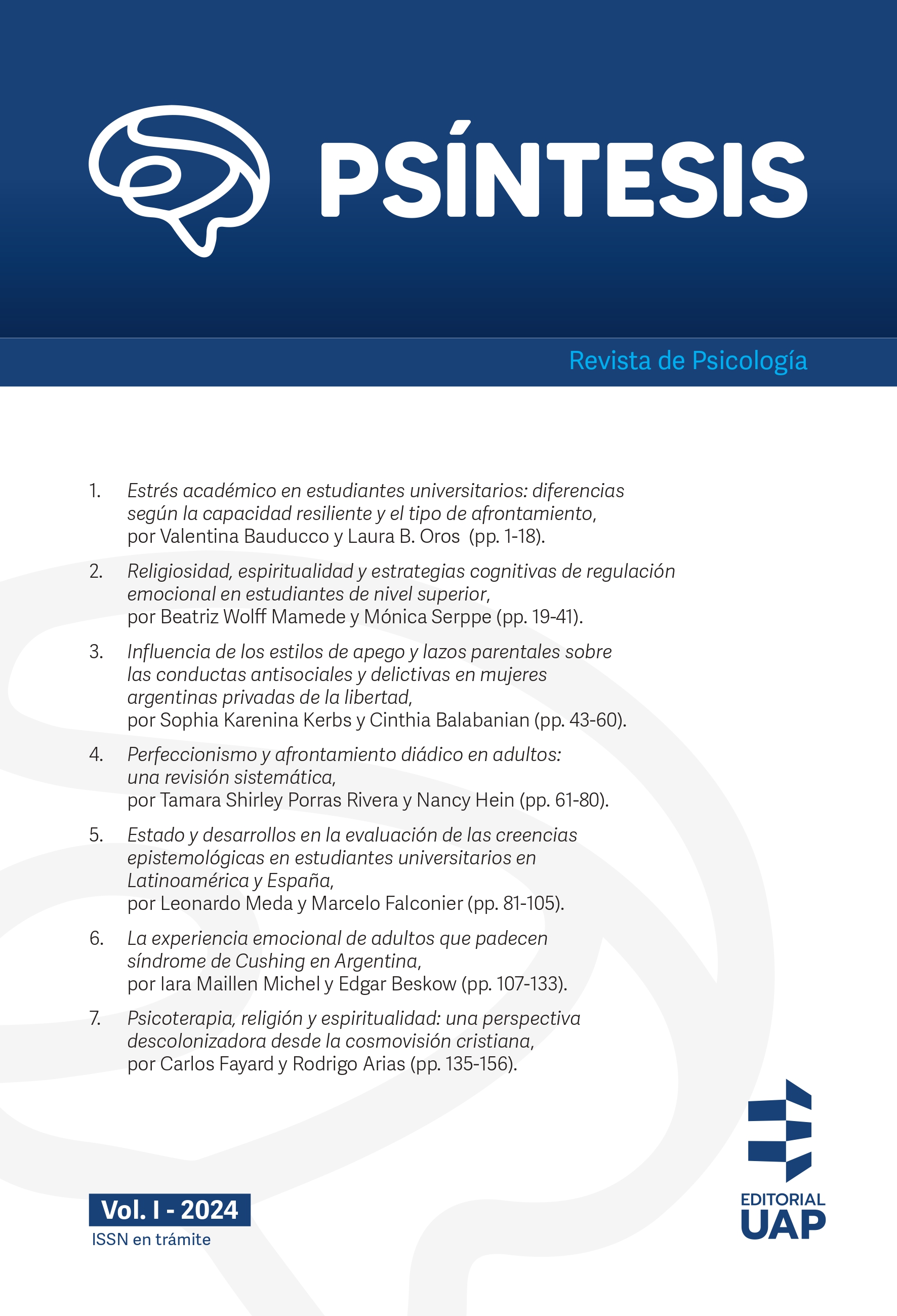The influence of attachment styles and parental bonding on antisocial and criminal behavior in Argentine women deprived of liberty
DOI:
https://doi.org/10.56487/gepbxs78Keywords:
Attachment — Parenting styles — Antisocial behaviors — Criminal behaviors — WomenAbstract
The present study aims to explore attachment styles and parental bonds as predictors
of antisocial and criminal behaviors in Argentine women deprived of liberty, specifically in penal units, through the application of three instruments and an ex post
facto cross-sectional study. The sample of participants consisted of 70 Argentinean
women deprived of liberty between 20 and 66 years old, housed in the women’s penal unit No. 6: “Concepción Arenal” (Paraná, Entre Ríos, Argentina), and in penal
unit No. 4: “Instituto de Recuperación de Mujeres” (Santa Fe de la Vera Cruz, Santa
Fe, Argentina), to whom the Non-Romantic Attachment Types Scale, the Parental
Styles Scales (PBI) and the Antisocial and Delinquent Behavior (A-D) questionnaire
were applied. Multivariate analysis of variance (MANOVA) was performed, the results of which showed that the dimension of the variable “attachment” with a significant effect on delinquent behaviors was “secure attachment”, while the dimension of
the variable parental ties with the greatest significant effect on antisocial and delinquent behaviors was “paternal affectivity”. These results suggest that the absence of
secure attachment is a risk factor for the development of delinquent behaviors, while
the absence of parental affectivity is a risk factor for the development of delinquent
behaviors.
References
Ainsworth, M. D. S. (1989). Attachments beyond infancy. American Psychologist, 44(4), 709-716. https://doi.org/10.1037/0003-066X.44.4.709
(1991). Attachments and other affectional bonds across the life cycle. En C. M. Parkes, J. Stevenson-Hinde, y P. Marris (Eds.), Attachment across the life cycle (pp. 33-51). Routledge. https://books.google.es/books?hl=es&lr=&id=4FKIAgAAQBAJ&oi=fnd&pg=PP1&dq=Attachment+across+the+life+cycle&ots=r6hZ_3wshx&sig=Jo2LmEBT2iHdGoFWIC1pKcLxCT4#v=onepage&q=Attachment%20across%20the%20life%20cycle&f=false
Ainsworth, M. D. S., Blehar, M. C., Waters, E. y Wall, S. (1978). Patterns of attachment: A psychological study of the Strange Situation. Erlbaum.
Bartholomew, K. (1994). Assessment of individual differences in adult attachment. Psychological Inquiry, 5(1), 23-67. https://www.tandfonline.com/doi/abs/10.1207/s15327965pli0501_2?journalCode=hpli20 (1990). Avoidance of intimacy: An attachment perspective. Journal of Social and Personal Relationships, 7(2), 147-178. https://journals.sagepub.com/doi/abs/10.1177/0265407590072001
Bobbio, A. y Arbach, K. (2019). Autocontrol y estilos de apego: su influencia en la conducta delictiva y en la agresión física de adolescentes argentinos. Revista Criminalidad, 61(3), 205-219.
Bowlby, J. (1969). El vínculo afectivo. Paidós.
Casullo, M. y Fernández, M. (2004). Evaluación de estilos de apego en adultos. Facultad de Psicología UBA, 183-192. http://www.scielo.org.ar/scielo.php?script=sci_arttext&pid=S1851-16862005000100018
Cuevas, C. A. (2003). Los factores de riesgo y la prevención de la conducta antisocial. En C. A. Cuevas (Ed.), Conducta antisocial: un enfoque psicológico (pp. 25-64). Pax.
Gago, J. (2014). Teoría del apego. El vínculo. Escuela Vasco Navarra de Terapia Familiar, 11, 1-11. https://gc.scalahed.com/recursos/files/r161r/w25707w/Teoria-delapego. -El-vinculo.-J.-Gago-2014.pdf
George, C., Kaplan, N. y Main, M. (1996). Adult attachment interview. University of California. http://www.cmap.polytechnique.fr/~jingrebeccali/research/nlp_files/AAI_Scoring.pdf
Gómez Maquet, R., Vallejo Zapata, J., Villada Zapata, L. y Zambrano Cruz, R. (2010). Propiedades psicométricas del instrumento de lazos parentales (Parental Bonding Instrument, PBI) en la población de Medellín, Colombia. Facultad de Psicología de la Universidad Cooperativa de Colombia. https://hdl.handle.net/10495/9114
Miotto, M. (2022). Perspectiva psicológica forense. Dunken.
Morais, M. (2018). Criminalidad femenina: análisis de factores sociales que inciden en el desarrollo de conductas delictivas en la mujer: una mirada desde el contacto con el sistema penal. Universidad Nacional de Quilmes. https://ridaa.unq.edu.ar/bitstream/handle/20.500.11807/912/TFI_2018_morais_015.pdf ?sequence=1&isAllowed=y
Rodríguez, G. M. (2008). Validación del método de la situación extraña de Mary Ainsworth en niños argentinos entre 1 y 3 años de edad. En XV Jornadas de Investigación y Cuarto Encuentro de Investigadores en Psicología del Mercosur. Facultad de Psicología de la Universidad de Buenos Aires. https://ri.conicet.gov.ar/bitstream/handle/11336/120077/CONICET_Digital_Nro.5151b2a8-7098-4f0d-800b-c13f6ef765d0_B.pdf ?sequence=5&isAllowed=y
Seisdedos, N. (2001). Cuestionario de conductas antisociales-delictivas (A-D). El Manual Moderno. https://www.academia.edu/26958312/Cuestionario_de_Conductas_Antisociales_Delictivas
Yárnoz, S., Alonso-Arbiol, I., Plazaola, M. y Sainz de Murieta, C. (2001). Apego en adultos y percepción de los otros. Anales de Psicología, 17(2), 159-170.


